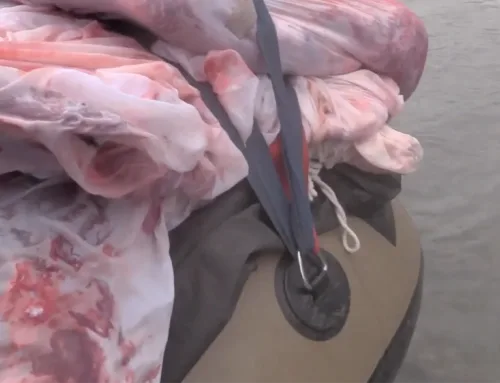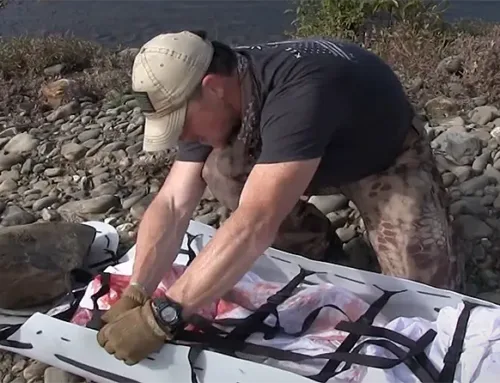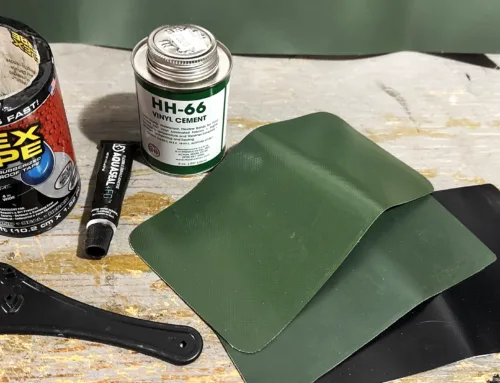Many Alaskans feel they have mastered survival through most situations. After all, this is Alaska…the unforgiving frontier land of opportunity. Nevertheless, many hunters venture afield each year with less than optimal awareness of the real dangers that lurk in the shadows of this vast land. However, if one performs the necessary steps before reaching ones remote hunting area, the hunt should remain an adventure, and not become a misadventure. Here are a few reminders on how to survive your next hunt.
Perform intensive research
Regardless of where and how long you plan to hunt a particular area of Alaska, you’ll need to study every aspect of that region. This should include such things as: area topography, typical weather for the time of year you’re hunting, animal distribution and movement habits, innate wildlife, and possible logistical support or re-supply points.
Once you have brain stormed these aspects, refine your research. Purchase topographical maps and contact the land managers responsible for the area in which you plan to hunt. Study the maps for possible travel routes, both human and wildlife. Speculate where animals will forage, traverse, bed, etc… This should help you when you’re actually in the area, and you will then be able to apply your personal knowledge of the terrain layout. To have both sound knowledge and respect for a region will most likely make your trip go smoother than blind exploration.
Know the speculated animal population of the critters you’re hunting. This should eliminate preconceived notions of how many animals you should or should not see. Innate wildlife data will also help you determine preventive measures for the safety of your group, such as having brown/grizzly bears visit your camp while away.
Logistical support and re-supply points are often needed, but when they aren’t available you must act as your own support. This requires advanced planning for transportation to and from the field, food reserves and re-supply, fuel for stoves, equipment repairs, etc. When hunting most areas of the state, this is certainly the rule and not the exception, so be prepared!
Plan for all weather
I’ve hunted many areas of Alaska and if I’ve learned one thing it is, you never know what the weather will be like on any given day or time. I’ve seen snow in May and July, rain in September, and 40-degree temperatures in October. This variance or uncertainty dictates that each hunter plan for all types of weather and temperatures.
Take this year’s sheep hunt, for instance. Our fly-in day presented with broken clouds and ambient temperatures in the 40’s. The next day temperatures averaged in the 30’s and we were pelted with mixed rain and sleet. Somewhere in the middle of our adventure we experienced gale winds greater than 30 mph for nearly 12 hours, with a wind chill of less than 30 degrees. The day of our departure it turned out to be clear skies and 50-degree temperatures, but the 3- to 6-inch snowfall kept us chilled; however, the reflection from the snow actually caused sunburn and itching, burning eyes.
These conditions are certainly common stories of Alaska hunts, especially during the fall (most hunting season periods). Scrupulously inspect your clothing and equipment, ensuring they are well suited to protect you from the forces of Alaska’s Nature.
Get in shape…stay in shape
The toughest obstacle hunters will face on any given Alaska hunt is their own physical limitations. We tend to use our body’s physical limitations as a pretext, instead of a tool for improving our success. Most hunts are physically demanding, even more challenging than words can express. Many hunts require the hunter to physically pack more than 50 percent of their body weights on their backs, often for distances much greater than a mile. If you’re not used to this aspect of hunting, your body will likely loose strength and your loss of endurance may end the hunt before it begins.
My hunting comrades always comment on my hiking speed and ability to carry outrageous loads of meat and equipment in my backpack. They seem to always attribute this feat to my age and body size. While age has a lot to do with general physical abilities, it doesn’t define your limitations. Moreover, my ability to comfortably backpack and traverse rouged terrain with a heavy load is due to my physical state and personal discipline to stay in shape, both physically and most importantly, mentally. Physical conditioning will make your days less grueling and help you sleep better at night. To sum it up nicely, the better shape you’re in, the less energy you expend while exerting yourself. Agility, speed, endurance, and generalized health are all aspects of your body that will make you a better hunter.
Plan all year for that two-week hunt in the Wrangell Mountains. Don’t overeat and under-exercise all year and think you’ll do fine on your hunt…you won’t!. Aerobic exercises, such as running, jazzercise, and bicycling will increase your cardiovascular fitness and thereby raise your body’s threshold for limitations. Weight training is also important for muscular fitness. Upper and lower body workouts will help reduced fatigue while hunting and hiking over strenuous terrain. Muscle and ligament stretches will improve your agility and endurance. Consider stretching before and after you hike, as well as maintaining a daily routine throughout the year. These are just a few ideas for improving your physical wellbeing. Find a program that works for you, and stick with it! You’ll be happy with the results.
Have the right equipment
Equipment quality is, without a doubt, the one aspect of your hunt that will determine how well you fare in any given scenario. It’s depressing to note how many hunters skimp on equipment in order to afford a more quality hunt, such as a fly-in. They reach their remote locale and have a miserable time because their equipment failed or was inadequate to begin with. Everything from waterproof matches to the type of clothing used is important. There are simple mistakes to be made which could be detrimental to your comfort and safety.
There are basic rules to follow when choosing the right equipment. These rules should be adhered to if one wishes to have a quality experience and prevent unnecessary discomfort or catastrophe. To begin with, equipment should be evaluated for its ability to guard your body against abrasive conditions, such as inclement weather, rugged terrain, etc.
This topic demands much more attention than can be given in this short mention, therefore, refer to more advanced sources for reviews and recommendations. Some great resources to assist hunters with gear purchase and preparation are:
A Complete Guide To Float Hunting Alaska, by Larry Bartlett
Caribou Hunting: A Guide to Alaska’s Herds, by Larry Bartlett
Backpacker Magazine (Gear Review issues), found in some libraries
Feed your body and feed it well
Food is fuel for your body, regardless of physical exertion. You’ll burn as many calories setting in a tent in 30-degree temperatures as you will pursuing a quick jaunt over light terrain. Your body uses food in ways only nutritional experts can fully appreciate. For the rest of us, we must understand and respect the fact that having the right food will keep you energized and healthy while afield.
Again, basic rules must be defined and followed where food is concerned. The obvious facts are, food is how we get our energy, and without food we can’t function at an acceptable rate and level. Although there are many aspects to an adequate diet, both in and out of the field, there are three basic elements that must be provided as fuel for the body. Let’s examine the basics that make carbohydrates, protein and fat important.
- Carbohydrates supply the body with energy. Glycogen is produced when carbs are digested, which fuels muscles and keeps them going mile after mile. The body also uses carbohydrates to produce triglycerides, which help fuel the brain and is conducive to a levelheaded approach to decision making (extremely important afield). Simple carbohydrates are burned fast by the body and can be supplied by fruit and candy. Complex carbs are found in breads, such as baked breads, crackers, tortillas, etc. These are stored longer and burn more slowly than simple carbs. They also add bulk to your diet, making you feel fuller than you really are.
- Protein is stored in the fat cells and muscles and actually helps the body repair fatigued and injured muscles. Without protein your body could not withstand the grueling punishment often inflicted in the backcountry. Protein also slows the release of insulin, which is released to burn glycogen (sugar). If your protein levels are not well balanced when you ingest a load of carbohydrates, a few hours later you’ll likely get weak and your hands may begin to shake. To test this theory eat a big stack of pancakes loaded with maple syrup, and wait three hours…you’ll know exactly what I’m saying is true. However, if you had eaten a stake and/or eggs (protein rich foods) with those pancakes, you’d likely not notice a thing except a higher energy level. Eggs, fish, milk, beans, meat and chicken are great sources for protein.
- Fats are more important to the body than many think. Society has placed fats in the realm of taboo foods that one should avoid at all cost, but that couldn’t be more false. The body uses fat to store glycogen (product of used carbs), water, protein, and all other important nutrients. The obvious purpose of fat is to insulate the body and distort its figure, but in proportional quantities it aids in the regulation of energy expenditure (fuel burning). Cheese, processed meats, nuts and margarine are a few sources of fats.
Remember these basics when preparing your meals. Also, remember your body typically uses double the normal caloric intake as it would on its normal daily routine. This could mean each person eating as much as 7,000 calories per day. Balance your meals, have a wide variety, and feed your body well.
Pace yourself
Boy, if I’ve learned one thing about endurance and having stamina for the long haul, it’s how to pace myself. Whether long-distance running, day hiking, or pursuing an extended pack-in/pack-out hunt, if you pace yourself accordingly you’ll maintain your energy level and increase your performance. This will most certainly affect the outcome of your next hunt.
This year I decided to hunt a particular river drainage from its headwaters. I arrived to the drop-off and found no sign of sheep; so I adjusted plans accordingly, stretched out the topographical maps, and placed my finger on a neighboring drainage about 8 miles to the east. Sounds easy enough! While I knew pacing would keep me going long after the march inward, my partner was doing his best to maintain the set pace. He said nothing to me until we were over several peaks and many miles had been put between the drop-off and us. He was out of energy and in need of serious R & R. It cost us about 12 hours of hunting because he could not saddle up for more. His pace was not properly met.
My advice is to always respect the slowest hunter’s pace. The old cliché insinuating that “you’re only as fast as the slowest team member” is certainly true when it comes to hunting. Let the slowest hunter set the pace for the rest of the group. This will actually save you time in the long run. Refer back to my anecdote and the 12 hours of hunting it cost me. What I thought of as a leisurely stroll over a few mountains must have felt like the Bataan Death March for my comrade.
Even if hunting with strong group members, use the pace system. Start out slowly, building energy as you warm up your muscles. If you’re on a 5-mile pack-in/pack-out, do a mile or two at a slow pace. Rest for a few hours, or over night; then, regain the pace, increasing the distance but not the speed at which you travel. In this situation the tortoise always wins the race. You’ll likely reach your destination and decide to go further, searching for the right trophy.
Prepare for lots of down time No matter how long your hunt is planned to be, you’ll likely find time to stare at the walls of your tent. There has been much tent time on every sheep hunt I’ve undertaken thus far. Whether driven to take shelter by inclement weather, or waiting for your departure flight out, you’ll regret not having some form of entertainment to occupy your free time. I recommend a good book and a deck of cards. While you’ll likely want to leave these heavy items in base camp, you can pre-draw a checker board and tick-tack-toe board on one side of your sleeping pad. Use small stones or snack mix as game pieces. This will serve as a lightweight form of amusement, even if on a sheep hunt.
Although many of these suggested survival tips may or may not be suited for your type of hunt, try to relate them to your hunting scenarios. You’ll likely see aspects of your adventure that can be improved upon. Should you have any questions or concerns, feel free to contact me.
-Larry Bartlett
Author / Wilderness Guide




